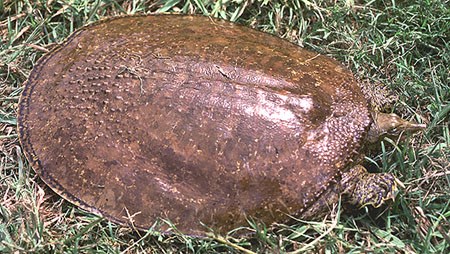
Brad Shaffer (USGS) Characteristics There are no scutes, the scales found on the carapace and plastron of most turtles. The snout is tubular and rather pig like with a ridge along the inner margin of each nostril and is upturned near the end which lets the turtle remain beneath the water surface with just the snout exposed to breath. The feet have claws and are webbed for swimming. Males have a carapace that feels like sandpaper which is marked with small, dark spots and circles and the tail is thick and long with the vent well beyond the rear end of the carapace. Females have a carapace that is not like sandpaper and which is mottled with blotches, but the tubercles are more prominent and the tail is rather short. The female’s carapace can grow to 20 inches while the males are about 16 inches. Females get darker with age, but males stay the same color throughout their life. Seven subspecies are known. Bottom Feeders Territory And Habitat Spiny Softshells prefer large rivers and river impoundments as well as lakes, ponds along rivers, pools along intermittent streams, bayous, irrigation canals and oxbows. They like open sandy or mud banks, and a soft or muddy bottom with submerged brush. They are capable of exchanging gas through their skin in both air and water and can stay submerged for up to five hours. They are active from April to October, but that varies according to their home range. During the winter they burrow into the bottom. Mating And Lifespan The typical clutch size will range from 20 to 40 hard shelled eggs, but as few as 6 and as many as 109 have been documented. A single clutch is laid and most mature females nest each year. The eggs hatch during August and September. Females may nest as early as age 8, but commonly the first clutch comes in the age range of 11 to 16 years. They sometimes live to an age of 50. |
Last updated: February 24, 2015
